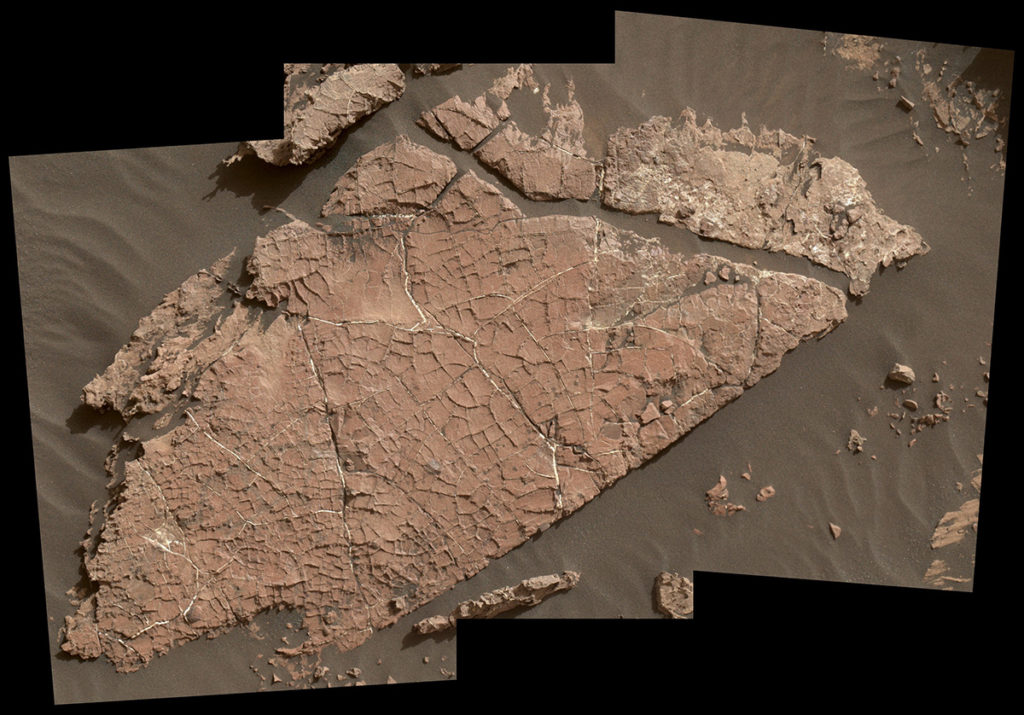
Evidence of possible past extraterrestrial life on Mars has emerged from the discovery of ancient mud cracks in the shape of polygons scattered across its surface.
In 2021, NASA’s Curiosity rover took pictures of unusual polygonal shapes on the slopes of Mount Sharp, a towering peak within Gale Crater. This crater is where Curiosity touched down in 2012 and has been exploring ever since. These shapes, featuring five or six sides, originated some 3.8 to 3.6 billion years ago.
At first, scientists believed these shapes were mud cracks, indicating that Mars was once significantly wetter. However, a fresh study published on August 9th in the journal Nature reevaluated these marks.
Surprisingly, the researchers found that these formations were created during wet-dry cycles, akin to Earth’s seasonal patterns. This revelation marks the first time such cycles have been identified on Mars.
“This is the first tangible evidence we’ve seen that the ancient climate of Mars had such regular, Earth-like wet-dry cycles,” remarked William Rapin, the head author of the study and a planetary scientist associated with the National Center for Scientific Research (CNRS) in France.
Rapin emphasized the significance of these wet-dry cycles, stating that they might be crucial and potentially necessary for the molecular changes that could pave the way for life to develop.
Presence of polygon mud cracks
The mud cracks were found above a layer containing clay-rich deposits, which once formed the floor of an ancient lake. Below these cracks lies a section abundant in sulfates, mineral residues left behind as water evaporates.
Initially, it seemed that these mud cracks emerged during the period when the old lake dried up. Notably, NASA reported that in 2017, the Curiosity rover stumbled upon similar T-shaped mud cracks at a site dubbed “Old Soaker,” located close to where these new cracks were found.
However, these fresh cracks exhibit signs of sulfates, indicating that they underwent multiple drying episodes during their formation. This implies that these cracks took shape during an era when the lake’s water level experienced repeated fluctuations, rising and falling.
This insight also clarifies why the current cracks have a polygonal appearance, differing from the T-shaped ones observed at Old Soaker. Over time, as these identical types of cracks formed repeatedly, they transformed into a more intricate polygonal shape, as detailed by researchers.
Wet-dry cycles and organic compound formation
According to researchers, a comparable pattern of alternating wet and dry periods on Earth offers a plausible explanation for the initial emergence of organic compounds. These compounds consist of molecules containing carbon and other elements and are present in all living organisms.
Scientists elaborate that ever-changing environmental conditions can consistently modify the array of chemicals available. As a result, these conditions promote chemical reactions wherein polymers, or sequences of molecules, gradually evolve into organic compounds such as nucleic acids. These nucleic acids serve as the building blocks of DNA.
Mars rovers have already made discoveries of organic compounds within various types of Martian rocks. Furthermore, scientists have detected these compounds within Martian meteorites that have collided with Earth.
However, it’s important to note that natural geological processes can also generate these compounds, and asteroids can transport them. This leads to the possibility that these compounds might have arrived on Mars through asteroid impacts.
Due to these complexities, scientists face challenges in definitively connecting these compounds to potential extraterrestrial life.
Mars’ mud cracks might link to life’s genesis
The recent discovery of alternating wet and dry cycles has unveiled a natural process that holds the potential to offer an explanation not only for the formation of these organic compounds but also for how they could have played a role in “initiating the emergence of life,” as stated by Ashwin Vasavada.
Frozen water on the surface of Mars splits the ground open into polygons, creating a mystical pattern in this image released by NASA on June 26 2022. NASA/JPL-Caltech/University of Arizona pic.twitter.com/GIfA2i6BqJ
— The Redheaded libertarian (@TRHLofficial) June 23, 2023
Vasavada, a scientist associated with NASA’s Jet Propulsion Laboratory in California and the Mars Science Laboratory, provided this insight in a statement. It’s worth noting that he was not directly involved in the study. This isn’t the first instance of observing peculiar polygonal shapes on the surface of Mars.
In March 2022, NASA’s Mars Reconnaissance Orbiter captured images of significantly larger polygons outlined in white. These perplexing formations were photographed from an aerial perspective.
The root cause behind these shapes was the presence of concealed reservoirs of ice that came into contact with the Martian surface, leading to their creation.
See all the latest news from Greece and the world at Greekreporter.com. Contact our newsroom to report an update or send your story, photos and videos. Follow GR on Google News and subscribe here to our daily email!



